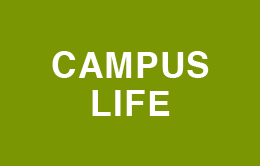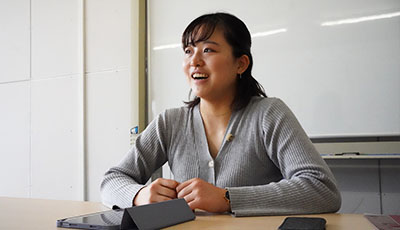
Towards the adoption of carbon-negative concrete across society
–Wanting to support infrastructure through technology
| Department of Civil and Environmental Engineering 4th year undergraduate |
| Maho Kaizaki |
| Mitsuyoshi Akiyama Laboratory |

Q What are you currently working on?
My research focuses on carbon-negative concrete. When you make traditional concrete, large amounts of CO2 are released into the atmosphere, a serious problem from an environmental perspective. Carbon-negative concrete, however, not only reduces CO2 amounts emitted during the manufacturing process but, when mixed with CO2-absorbing materials, it can actually bring CO2 emission levels below zero.
In particular, this kind of research deals with the development of a new Sorel cement that adsorbs CO2 and incorporates it as magnesium carbonate into its components. The production of magnesium carbonate to be used as raw concrete material is an original process developed by Professor Takao Nakagaki of the Department of Modern Mechanical Engineering.
On the other hand, my research focuses on finding the optimal combinations and proportions of different additives in order to improve the functionality of the concrete. For a product to be used as concrete, it must meet certain standards in terms of compressive strength, water resistance and setting time.
As an experiment, we made small concrete cylinders and tested their strength by compressing them with a compression testing machine. After the concrete had hardened, we immersed it in water for a certain period of time and compared variations in strength.
Pursuing research as an international team
Q Tell us how you came to choose the Akiyama Laboratory.
In my research on structural systems, I was particularly fascinated by the structure of concrete. I chose the Akiyama Laboratory based on my impressions of the lectures and the laboratory. In the Akiyama Laboratory students work in groups on a single topic, so one of the plus points is that we can do research while holding discussions with senior students and classmates.
My group includes undergraduate students, master’s students, doctoral students and assistant professors, and everyone except me is an international student. I also like the fact that Japanese and English are being used interchangeably. I’ve become good at building good relationships with my team members by using humor to communicate with them.

With fellow lab members.
Using technology to support infrastructure we always take for granted
Q Tell us what you intend to do in the future.
I want to continue working in civil engineering. Even in a society that changes at a dizzying pace, infrastructure will be necessary as long as humans are alive, and ensuring that it continues to function in a stable way is extremely important. We tend to pay attention to infrastructure when it breaks down and stops functioning during emergencies like natural disasters, but I want to work to make sure it continues functioning as a matter of course even during an emergency.

